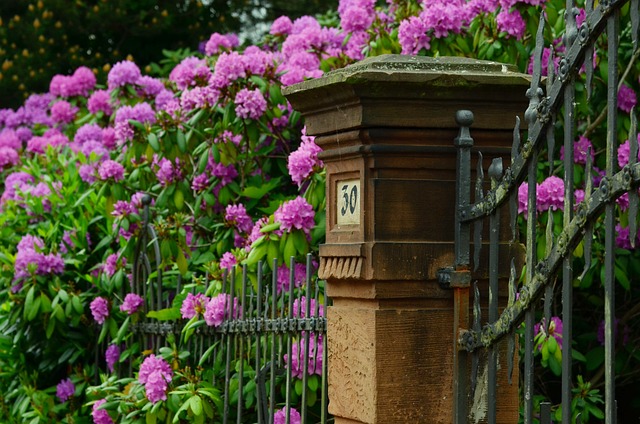Introduction:
Maintaining an appealing wooden fence is effortless with the right techniques—particularly when incorporating fence staining and sealing. This comprehensive guide delves into the art of enhancing your outdoor space. We’ll explore the advantages and diverse types of fence staining, from semi-transparent to solid colors. Preparation is key; we’ll teach you how to ready your fence for optimal absorption. Additionally, we’ll navigate color choices, sealing techniques for prolonged protection, and simple maintenance tips to ensure your wooden fence stays beautiful for years to come.
- Understanding Fence Staining: Benefits and Types
- Preparing Your Wooden Fence for Staining
- Choosing the Right Stain: Color Options & Applications
- Sealing for Protection: Why and How
- Maintenance Tips for Long-Lasting Results
Understanding Fence Staining: Benefits and Types
Fence staining is an essential process that not only enhances the aesthetic appeal of your wooden fence but also serves as a protective layer against the elements. By understanding the benefits and various types of staining, you can make an informed decision to preserve and improve the look of your outdoor space. One of the primary advantages is its durability; stains create a barrier, shielding the wood from UV rays, rain, and snow, which can cause fading and rot over time. Regular application can extend the life of your fence significantly.
Staining offers a wide array of options to match any preference or style. Water-based stains are popular for their low odor and quick drying time, making them environmentally friendly and easy to apply. Oil-based formulas, on the other hand, provide deeper colors and longer-lasting protection but may emit stronger odors and take longer to dry. Solid color stains offer a uniform look, while transparent options allow the natural grain of the wood to show through, creating a unique, rustic appeal.
Preparing Your Wooden Fence for Staining
Before applying any stain or sealant, preparing your wooden fence is a crucial step in ensuring optimal results. Start by cleaning the fence to remove any dirt, dust, or debris that might hinder the staining process. Use a pressure washer or a stiff-bristled brush and mild detergent to thoroughly clean the surface. This initial step will help the stain adhere better and create a more even finish.
Once cleaned, inspect the fence for any damaged or rotten sections. Repair these areas using appropriate wood replacement techniques. Fill in cracks, holes, or missing pieces with wood putty or matching repair compounds. Sand the repaired sections smooth after they’ve dried to ensure an even surface. This preparation guarantees that your stained fence looks uniform and durable.
Choosing the Right Stain: Color Options & Applications
When it comes to enhancing your wooden fence, selecting the perfect stain is a crucial step. The market offers an array of options in terms of color, each serving different purposes and aesthetic needs. From rich, deep hues that add drama to your outdoor space to subtle, natural shades that blend with the wood’s inherent beauty, the choice is vast. Consider the ambiance you wish to create; a dark stain can make a fence appear more formal and dramatic, while lighter tones can offer a relaxed, rustic charm.
Additionally, different applications are available, such as oil-based stains, water-based stains, or semi-transparent finishes. Oil-based stains penetrate deeper into the wood, offering excellent durability and protection against fading. Water-based options, on the other hand, are more environmentally friendly and easier to clean up but may not provide the same level of resistance to weather changes. Semi-transparent finishes allow some light to pass through, showcasing the natural grain of the wood while still providing a protective layer.
Sealing for Protection: Why and How
Wooden fences, when left unprotected, can be susceptible to the elements, resulting in fading, cracking, and eventual rot. Sealing is an essential step in fence maintenance that provides a protective barrier against these issues. It acts as a shield, preventing water, moisture, and UV rays from penetrating the wood’s surface.
The process involves applying a special coating or varnish designed to withstand outdoor conditions. This sealant not only enhances the aesthetic appeal of your fence but also extends its lifespan significantly. By creating a protective layer, sealing preserves the natural beauty of the wood, ensuring it remains vibrant and durable for years to come.
Maintenance Tips for Long-Lasting Results
Regular maintenance is key to achieving and maintaining long-lasting, vibrant fence staining results. After initially applying a coat or two of stain, it’s essential to establish a yearly upkeep routine. This involves cleaning the fence surface annually to remove any built-up dirt, mold, or mildew that can hinder the adhesion of new coats. Use a pressure washer or soft brush and mild detergent for this step, ensuring you don’t damage the wood.
Additionally, reapplying a fresh layer of sealant every two years is crucial. Sealants protect the stain from UV rays, extreme weather conditions, and general wear and tear. By keeping up with these simple maintenance tasks, you’ll ensure your wooden fence remains beautiful and well-protected for many years to come.
